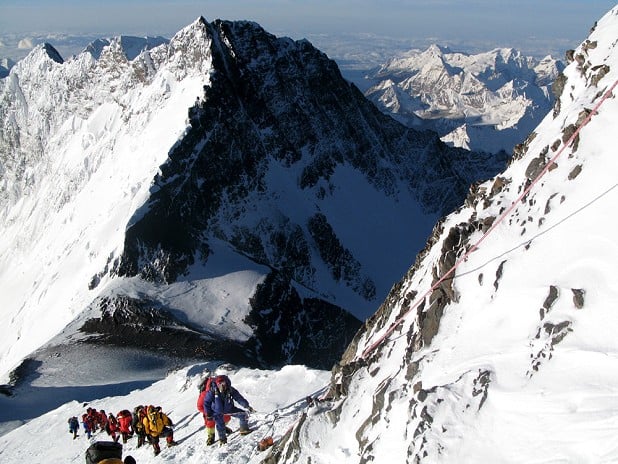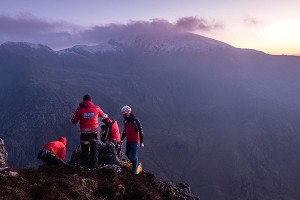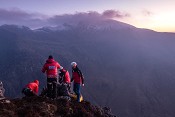
A new study shows that Mount Everest's highest glacier is losing a significant mass of ice through melting and is 'destined for rapid retreat', with the potential to disappear by mid-century. The research team led by the University of Maine discovered that the South Col glacier - situated at an altitude of 8,020m - has lost more than 54 metres in depth in the last 25 years, accelerated by a combination of rising temperatures, snowpack loss, strong sunlight and fierce winds.
One of the study's authors, climber and climate scientist Dr Tom Matthews from King's College London, told UKC:
"The reason for this rapid mass loss appears to be due to recent loss of the snowpack, which is consistent with a gradual but sustained long-term increase in sublimation [when ice changes state to water vapour] due to climate warming. Now darker ice has been left exposed, the extraordinarily strong sunshine that illuminates Everest's upper slopes can rapidly "burn" through the glacier, melting away ice that took decades to accumulate within a single year."
Although glacier melt research is prevalent and ongoing across the globe, this study is the first to analyse a glacier located at around 8,000 metres — the highest ice mass in the world.
Since 2000, warming has doubled in the Himalayas, leading to the loss of eight billion tonnes of ice per year.
Analysis of a 10-metre-long ice core taken from Everest's South Col glacier in 2019 showed that ice formed over 2,000 years has completely melted away since the 1990s — a rate of loss roughly 80 times faster than it took for the ice to accumulate on the glacier's surface.
The study also highlights the potential for 'surprises' which can occur through incremental shifts - let alone abrupt changes - in the climate. Dr Matthews told UKC:
"For the South Col, we find that glacier thinning occurs about twenty times faster once (darker) ice is exposed. Metaphorically, what was equivalent to a dripping tap suddenly becomes a raging torrent. It's a reminder that environmental impacts we've seen from warming to date can be a poor guide as to what happens next."
The study notes that warming will also change the nature of Everest ascents, as loose bedrock is exposed and the Khumbu icefall and snowpack become even more dynamic, while increased glacier melt threatens the safety of climbers at Khumbu Base Camp and communities living near the mountain.
At an estimated thinning rate approaching two metres per year, even ice masses such as the South Col glacier that are above 8,000 metres may disappear by mid-century, the study suggests, concluding that Everest's highest glacier 'has demonstrated that even the roof of the Earth is impacted by anthropogenic [caused by human activity] source warming.'
Study background from a COP26 event: Climate Science at the Top of the World
At a COP26 Green Zone event in Glasgow last November, Dr Matthews spoke about installing the world's highest automatic weather stations on Everest's balcony and South Col glacier in 2019 - which provided the data for this latest study - with a team of Sherpas as part of the National Geographic and Rolex Perpetual Planet Everest Expedition. A film of the expedition featured all experiments undertaken, including digital scanning and the extraction of ice cores and lake sediment cores.
Reflecting on early data from the stations, which measure temperature, air speed and pressure, wind and humidity, Dr Matthews explained to the audience: "From a meteorological perspective, conditions on Everest are as extreme if not more extreme than we expected." Winds are reaching up to 150km/h, posing a risk to climbers while sublimating crucial top layers of snow and ice from the South Col glacier.
As the climate warms, the lower atmosphere thickens, which leads to increased pressure and therefore oxygen levels higher up — good news for oxygen-depleted climbers, but it's nonetheless an indicator of extreme climate conditions. "The biosphere [living organisms] is also rising to occupy that space," Dr Matthews said.
The data also shows unexpected temperature differences near Everest's summit: although the air temperature reaches -10°C at its warmest, the temperature of the snow and ice is measuring around 0°C — the melting point, suggesting that the ice is more sensitive to warming than predicted.
Everest's South Col, Dr Matthews explained, is probably one of the sunniest spots on Earth: sunlight bounces off the snow, then is reflected back down by clouds and concentrated on the upper slopes —making the light stronger on the surface of the mountain than at the top of Earth's atmosphere. "The future of the glacier is dependent on more than just current weather conditions, but how sensitive it has been to past warming," Dr Matthews said.
In high mountain Asia, for every 0.1 of a degree of warming, an additional 1% of ice is lost. "If melted, the water would be enough to fill a 1km wide lake stretching from Glasgow to Edinburgh," Dr Matthews explained. "Even with no more warming, we'd still expect to see 15% of the ice here lost by the end of the century. We'd be left with 2/3 under a 1.5°C scenario by the end of century."
Data from the weather stations can provide early warnings about rainfall, floods, heavy snow and debris flows to local communities. Understanding these impacts feeds into policies implemented on the ground by governments. "The people living under the Himalayan water towers have done little to contribute to the problem, but are dealing with the impacts," Dr Matthews said.
The loss of snow and ice is also a cultural loss. The Sherpas have seen mountains change "from white to black" following the retreat of snow and glaciers revealing the bedrock underneath, Dr Matthews explained. Sherpas have played a key role in maintaining the weather stations since their installation.
Dr Matthews expressed the need for similar stations on other peaks across the globe. "The high altitude data void needs to be filled to find consequences of warming on upper reaches of our planet. The high profile bytes of the data void have been taken, but now we need to get into and climb high in other mountain ranges," he said. Other stations have been installed on Mt. Tubengatu in Chile and Mt. Logan in Canada.
"We need to come out of this COP with a stronger commitment to warming as close as possible to 1.5°C. Limiting warming as much as possible is really important," Dr Matthews concluded.
National Geographic's Mt. Everest weather station archive is open access. Watch the replay of this event:
















Comments
Good to see some reporting on this finally, well done